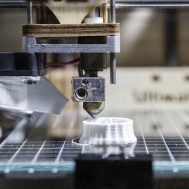According to Wohlers Associates, the global 3D printing market is expected to reach $21 billion by 2020 — quadrupling its size in just four years. While 3D printing, also referred to as additive manufacturing, comes with many benefits, such as freedom of design, easy prototyping, customization and streamlined logistics, it also poses many challenges.
In order to fully leverage this transformational technology, we identified five 3D printing challenges that manufacturing leaders must understand.
1. 3D printing isn’t standardized.
While 3D printing allows engineers to produce single items inexpensively, it sometimes comes at a cost to quality. Aside from high-end machines that costs millions of dollars to purchase, many 3D printers produce good that are inferior to those made through traditional manufacturing. One of the reasons for this is a lack of universal standards.
“Put simply, many manufacturers and end users have difficulty stating with certainty that parts or products produced via 3D printing—whether all on the same printer or across geographies—will be of consistent quality, strength, and reliability,” the experts at Deloitte note. “Without this guarantee, many manufacturers will remain leery of AM technology, judging the risks of uncertain quality to be too costly a trade-off for any gains they might realize.”
The American Makes & ANSI Additive Manufacturing Standardization Collaborative (AMSC) is taking steps towards ending this uncertainty. The group’s mission is to develop consistent and harmonized industry-wide standards and specifications in order to facilitate growth of the sector.
2. Additive manufacturing impacts the environment.
The most popular material use for 3D printers is plastic filament. While this plastic is high quality and relatively inexpensive, its byproduct ends up in landfills. This practice contradicts our environmental movement to reduce our reliance on plastic. In order for widespread 3D printing to work in the industry, the byproduct must be reused.
Another issues regarding the use of plastic is its energy use. A study done at Loughborough University found that 3D printers consume about 50 to 100 times more electrical energy than injection molding when making an item of the same weight. Similarly, a program at MIT found that laser direct metal deposition uses hundreds of times the electricity as traditional machines.
Additionally, desktop 3D printers, which are widely accessible for rapid prototyping and small-scale manufacturing in home and office settings, release potentially harmful nanosized particles in indoor air. In order to avoid adverse health effects, 3D printers for industrial use must come equipped with exhaust ventilation or filtration accessories and be used in an adequately ventilated environment
3. Equipment and product costs are high.
One study done by Stratasys Direct found that equipment cost was the number one concern for professional users of 3D printers. While it’s fairly easy and inexpensive to print with plastic, metal printers required by big companies can easily costs tens of thousands of dollars. Even when manufacturers have access to this equipment, the process moves very slowly.
Unlike traditional manufacturing, there are high costs associated with producing large volumes of certain products using 3D printing. The time it takes to produce an object with 3D printing, for example, depends on the number of layers that need to be printed and the speed of the printer (which depends on the speed at which it can extrude the raw material used). Today’s metal printers can take days to print, as even new machines that use metal powders only build between 5 and 40 centimeters per hour.
4. There’s a 3D printing knowledge gap.
As 3D printing infiltrates the industry, there aren’t enough employees who have the background to design, perform and operate the machines.
In order for additive manufacturing to become a common method, manufacturing companies must invest time and money in employee training for both incoming and seasoned engineers. This can come at a challenge, though, since seasoned manufacturers are often reluctant to learn new technology.
Some universities, such as the Massachusetts Institute of Technology and the Georgia Institute of Technology, are preparing engineering students by launching 3D printing labs that deliver hands-on training.
5. Additive manufacturing complicates intellectual property.
Since additive manufacturing designs can be printed by anyone at any time, it changes the way we see value — shifting the value from the object itself to its design.
The consequences of not addressing IP concerns can be particularly harmful. If anyone can print a pirated or unprotected design independent of the intended quality or design measures, this creates security concerns for the public and liability issues for the designer.
“Weapons are one such example, with some designs of gun assemblies currently publicly available,” Deloitte’s Matt Widmer and Vikram Rajan explain. “However, it is currently unclear who, if anyone, will be held responsible for enabling a legally unfit individual to access a lethal tool for unsanctioned use.”
What 3D printing challenges have you faced?
Does your manufacturing facility utilize additive manufacturing? What challenges have you faced? We’d love to chat! Let us know and tweet us @AppleRubber.
